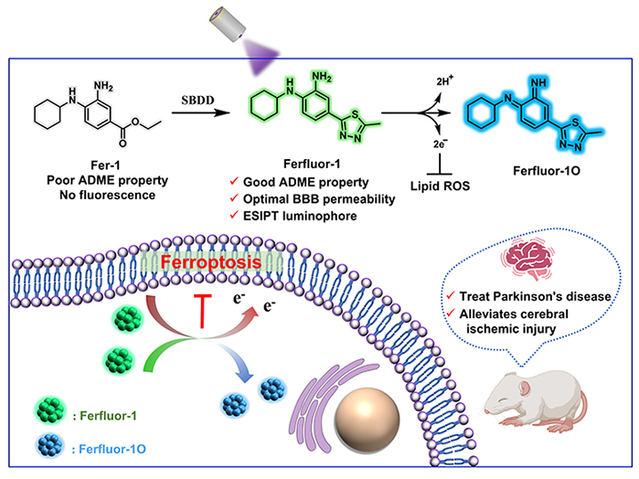Recently, Professor Wang Yong and Professor Qiu Xue from School of Medicine and Pharmacy and Laboratory for Marine Drugs and Bioproducts at Qingdao National Laboratory for Marine Science and Technology have made significant research progress in the design and development of small-molecule inhibitors and probes for ferroptosis. Their joint research findings, titled A Druglike Ferrostatin-1 Analogue as a Ferroptosis Inhibitor and Photoluminescent Indicator (Ferfluor-1), have been published in the internationally prestigious journal Angewandte Chemie International Edition.
Ferroptosis is a form of cell death driven by lipid peroxidation, which is closely associated with the development of neurological diseases such as stroke and Parkinson's disease (PD). Ferrostatin-1 (Fer-1), the most commonly used ferroptosis inhibitor, faces challenges such as poor pharmacokinetic properties and difficulty in crossing the blood-brain barrier (BBB), which severely limit research into ferroptosis-related mechanisms and the development of targeted therapies for neurological disorders. Additionally, the design of specific fluorescent probes for real-time monitoring of ferroptosis remains a significant challenge in studying the chemical biology mechanism of ferroptosis.
The research team designed a novel probe, Ferfluor-1, which combines potent ferroptosis inhibition with real-time monitoring capabilities, offering an effective strategy for the diagnosis and treatment of ferroptosis-related diseases. Ferfluor-1 is derived from the classic ferroptosis inhibitor Fer-1 through a bioisosteric replacement strategy. By innovatively introducing a 1,3,4-thiadiazole group, this modification significantly enhanced metabolic stability (with a half-life extended by 8-40 times) and BBB permeability, which is suitable for in vivo studies of brain diseases. Long-term toxicity tests in mice indicated that Ferfluor-1 is safe even at a high dose of 50 mg/kg, demonstrating its potential as a highly effective ferroptosis inhibitor candidate with low-toxicity. Ferfluor-1 emits green fluorescence through solvent-mediated excited-state intramolecular proton transfer (ESIPT), and its fluorescence signal can shift from 525 nm (green) to 436 nm (blue) under oxidative stress. The probe exhibits excellent selectivity and responsiveness to various phospholipid peroxides, enabling precise detection of lipid peroxidation processes. With these unique properties, Ferfluor-1 can be used as a specific ferroptosis detection probe, capable of dynamically quantifying and accurately tracing ferroptosis.

